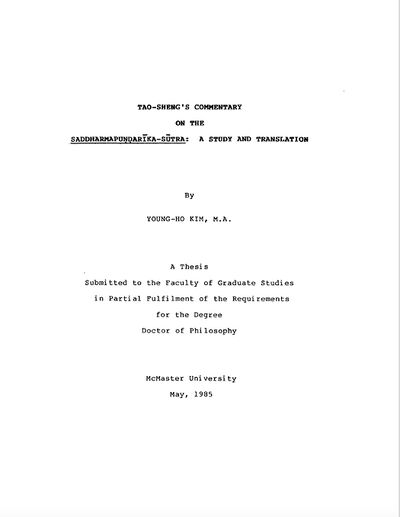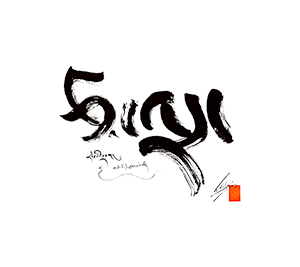- ABSTRACTiii
- ACKNOWLEDGEMENTSvi
- PART I: AIMS AND METHOD1
- NOTES TO PART I16
- PART II: INTRODUCTION20
- A. Tao-sheng's Pre-history: the State of Buddhist Studies in China20
- B. Tao-sheng's Biography36
- 1. Biographical Sources36
- 2. Tao-sheng's Life38
- a. Early Years in Chien-k'ang under Chu Fa-t'ai38
- b. The First Sojourn at Lu-shan with Hui-yüan40
- c. Study with Kumārajīva in Ch'ang-an43
- d. Return to Lu-shan45
- e. The Second Sojourn at Chien-k'ang46
- f. The Third Sojourn at Lu-shan and Death47
- g. Evaluation of Tao-sheng's Life48
- C. Tao-sheng's Works53
- D. Tao-sheng's Doctrines60
- 1. Sudden Enlightenment61
- 2. The Buddha-nature and Related Ideas74
- 3. Miscellaneous84
- a. The Good Deed Entails No Retribution85
- b. There is No Pure Land in [the Realm of] the Buddha89
- c. The Dharmakāya is Formless94
- d. On the Two Truths101
- E. Tao-sheng's Influence and the Impact of his Doctrines106
- 1. The Doctrine of Sudden Enlightenment107
- a. The Contemporary and Following Period107
- b. Tao-sheng's Doctrine and the Ch'an School111
- c. Tao-sheng's Doctrine and the Hua-yen School121
- 2. The Doctrine of Buddha-nature125
- 3. Tao-sheng and Other Schools129
- a. Tao-sheng and the T'ien-t'ai School129
- b. Tao-sheng and the San-lun School133
- 1. The Doctrine of Sudden Enlightenment107
- NOTES TO PART II137
- PART III: A CRITICAL STUDY OF TAO-SHENG'S COMMENTARY ON
THE SADDHARMAPUṆḌARĪKA156- A. Tao-sheng and the Saddharmapuṇḍarīka156
- B. Literary Aspects163
- 1. Structure163
- a. General163
- b. Preface164
- c. Interpretation of Chapters 1–27165
- 2. Style and Exegetical Method167
- a. Style167
- b. Exegetical Method169
- 3. Vocabulary: The Language of the Text with Special Reference to Neo-Taoism171
- a. Introduction171
- b. Analysis of the Concepts174
- (1) Li174
- (2) Fen180
- (3) The Role of Language183
- (4) The "Sage" and Related Terms188
- (5) The Emotional Factor207
- (6) Lei212
- (7) One Ultimate214
- (8) Middle Way (Chung-tao)218
- (9) Tao222
- c. Concluding Remarks224
- 1. Structure163
- C. Central Ideas228
- 1. Main Themes228
- 2. An Overview of the Internal Stucture of the Commentary via the
Term Li235- a. Introduction235
- b. Syntactical and Contextual Position237
- c. Predicates, Properties, and Epistemic Implications239
- d. Li Viewed in Connection with Other Concepts242
- e. Li and the Process of Enlightenment256
- f. Concluding Remarks264
- D. Traces of Tao-sheng's Doctrines268
- 1. Sudden Enlightenment269
- 2. Buddha-nature274
- 3. Miscellaneous275
- E. Select Chapters for a Comprehensive Textual Analysis283
- 1. Chapter 3284
- 2. Chapter 15301
- 3. Chapter 24308
- 4. Summary and Conclusion311
- NOTES TO PART III317
- PART IV: CONCLUSION339
- NOTES TO PART IV346
- PART V: TRANSLATION348
- Preface348
- Roll the First (Chapts. 1–4)352
- Roll the Second (Chapts. 5–27)453
- NOTES TO TRANSLATION535
- ABBREVIATIONS580
- BIBLIOGRAPHY581

